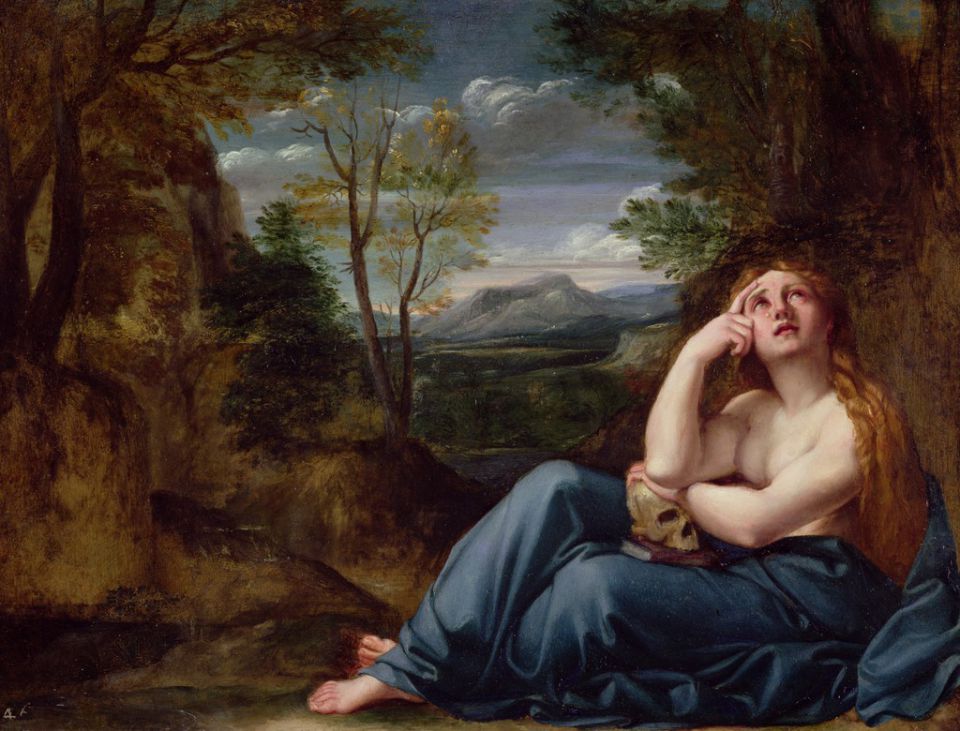Secrets of the Baptist
John the Baptist, Jesus' cousin
It seems to me that Mary Magdalene was among those who saw Jesus baptised; here are two pictures which imply this.
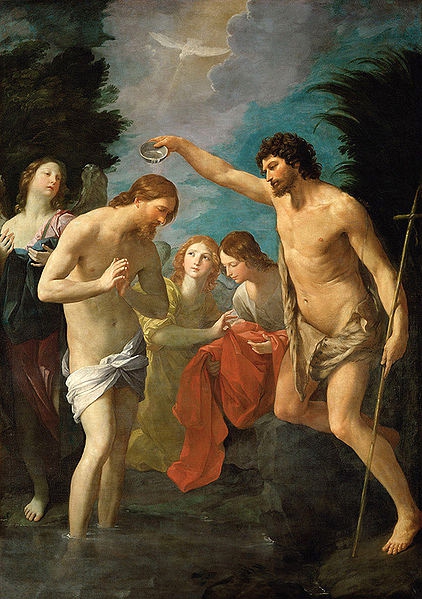
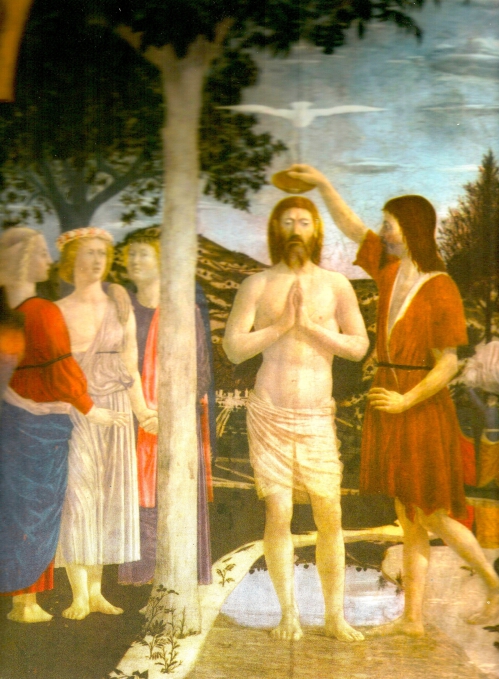
(It is a much later idea, pouring water on Jesus' head from a dish. At the time, it was whole body immersion.)
Jesus’s baptism took place in the River Jordan, not far from Bethany where Mary Magdalene lived with her older sister Martha, her younger brother Lazarus, and her father Simon. What did the ceremony consist of?
The Coptic Church in Egypt, founded by St. Mark around 50AD, is one of the oldest in the world. The Coptic Christians are the closest to original Christianity and they do not even believe that Jesus was the Son of God, although they are being pressurised by the Catholic Church to change their position on this. Their ceremonies are long and intense, a Coptic friend told me, and during the ceremony of baptism the initiate has to suffer complete immersion three times.
This form of baptism continued for a long time; the French king Clovis was baptised naked in a special tub.
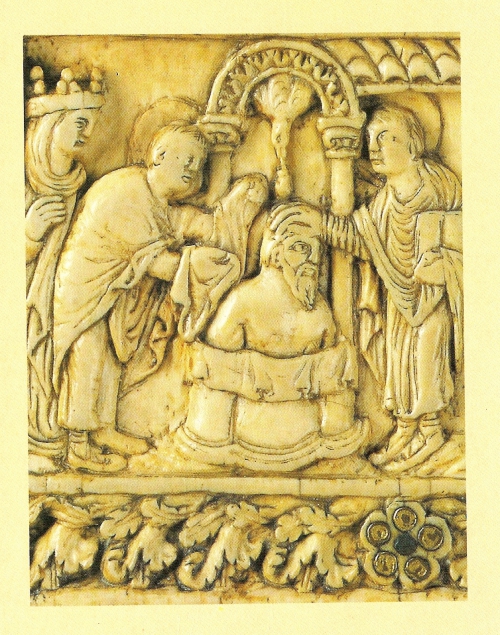
A carving done on marble of the Baptism of Clovis by Remi in 493AD
The modern Baptist church in the States and Great Britain also “initiates’” its members by whole body baptism. People are not however, undressed, and are merely tipped over backwards, while supported, for a split second under the water. You can see dozens of films on Youtube and the style of baptism varies; click here my favorite one.
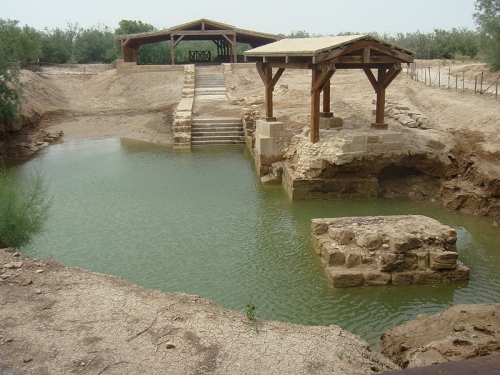
The spot where Jesus was baptised; you can take tours there from Bethany and Jerusalem
There is no doubt from the Bible that baptism was the initiation ceremony for adults who wanted to follow a new faith. John the Baptist actually created what we call Christianity, he was baptising people already, and preaching, before Jesus came along. The Bible makes this clear.
St Matthew’s words were; “People came to him from Jerusalem, from the whole province of Judea, and from all the country near the River Jordan.” This could have been copied from St. Mark; John appeared in the desert, baptising and preaching. “Turn away from your sins and be baptised,” he told the people, “and God will forgive you your sins.” Many people from the province of Judea and the city of Jerusalem went to hear John. St Luke’s version had some additional words which make it clear that John was a preacher - Luke, 3, 3-15.
Later in Luke is a strange incident when John the Baptist sent messengers to Jesus; it is apparent they came from John who was in prison. “All the people heard (the messages), they and the tax collectors were the ones who had been baptised by John. But the Pharisees and the the teachers of the law rejected God’s purpose and refused to be baptised by John.” (Luke 7, 29-30) This makes a separation between Judaism and Christ's religion quite clear.
St. John’s Gospel writes about Gnosticism and continues straight to John’s message (to be cleansed of your sins by water.) Verses 29 to 34 in St. John imply this was an orchestrated presentation to the people of Jesus as the Messiah, possibly because both John and Jesus suspected John would soon be imprisoned by Herod and they wanted to preserve their faith. It says later in John’s Gospel that Saint Andrew followed John the Baptist before he followed Jesus. As Andrew was the brother of Saint Peter this is indeed thought-provoking. At the time Jesus started his ministry there was already a new religion in the making, and that Andrew and Peter believed in it.
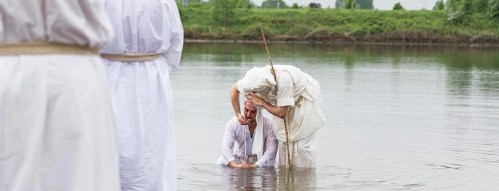
Mandeans baptising today
The mystery is that John the Baptist was a Mandean. Mandeans now live in Irak but at the time of John and his cousin Jesus, they lived and practiced their religion alongside the Jews, whom they did not like. Their religion was never Judaic in origin and their history says they originated in Egypt in the second century BC, while modern scholars define them as Gnostic.
This is incredible news and explains why the Pharisees and Herod hated both John and Jesus; by the time of his crucifixion, Jesus had received death threats from them both.
What John the Baptist preached, and later what Jesus preached, was definitely not Judaism, nor did it descend from the Old Testament. What John the Baptist and his cousin Jesus believed was not Judaism.
I’m told the inclusion of the Old Testament was to prove that Jesus fulfilled the old prophecies of the Messiah but the “new religion” was quite unlike Judaism. It was based on love and personal knowledge, it was not based on vengeance and following commandments. In the Bible Jesus was often breaking commandments, to the rage of the Pharisees, and Jesus never showed any trace of the punitive personality of the vengeful Jehovah. To assume that "God" in the Trinity was Jehovah is ridiculous/
You can watch a film about the Mandeans here. I was very moved by it.
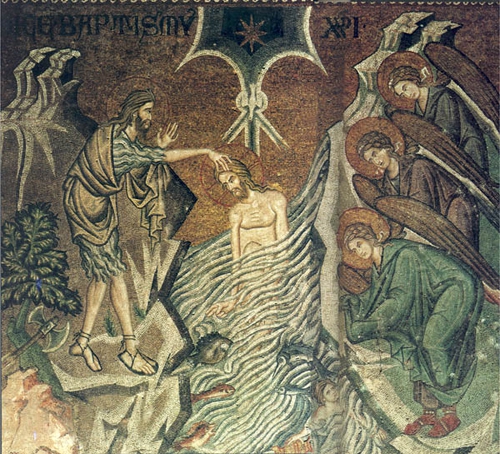
Here is an apparently 8th century image of Jesus being baptised by John. Note John's hand on Jesus' head and compare to the Mandean picture above, and the film about Mandeans.
Not long after the messengers incident Jesus was in the house of Simon the Pharisee and Mary Magdalene, the daughter of the house, washed his feet and dried them with her hair. This was courtesy to a guest, but Simon had not offered it, only Mary. I think Mary had seen Jesus baptised and fallen in love with him then - see my article about it on this site by clicking here. Why Simon did not treat Jesus to common courtesy we can only speculate, but he was a Pharisee and jesus's cousin, and now him, had been leading a religious movement that denied Judaism.
She then, and other women too, travelled with Jesus and the disciples “preaching the Good News about the Kingdom of God.” The women are named as Mary Magdalene, Joanna, and Susanna “and many others.” It does not say the women baptised people, but I believe they did. The Mandeans saw water as the source of life which refreshed the soul, enabling it to grow towards the light. Jesus sometimes spoke in metaphors and similes. One was; “People do not light a lamp and cover it with a bowl or put it under a bed, instead, they put it on the lampstand so people can see the light as soon as they come in.”
The emphasis on baptism in Jesus's new religion could explain why, Mary Magdalene and Jesus escaped after the crucifixion and came to Languedoc, they went specifically to the Roman town near Narbonne called Aquae Calidae - warm waters - known known as Rennes-les-Bains. In the town are five warm springs, many cool mineral sources and the river Sals, which is slightly salty and ideal for baptisms.
It was certainly suitable for those who saw water as life-giving and sacred.
Inscrivez-vous au site
Soyez prévenu par email des prochaines mises à jour
Rejoignez les 254 autres membres
